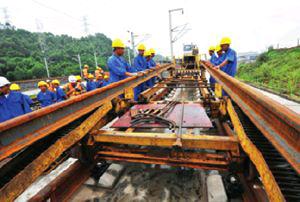MINI-STIMULUS,MAXIMUM EFFECT
2014-08-27ByDengYaqing
By+Deng+Yaqing
Earlier this year, in a bid to combat an economic slowdown, the Chinese Government launched several policies, such as cutting reserve requirement ratios for certain banks, increasing railway investment, reducing taxation on small and micro-businesses, and quickening renovation of shantytowns. Some in the media have begun to refer to these policies as “mini-stimulus” measures, because the government has reiterated its determination to steer away from stimulus efforts featuring massive investments.
These policies have yielded tangible results visible in some economic indicators. According to the latest figures from the National Bureau of Statistics, GDP growth accelerated to 7.5 percent in the second quarter from the 7.4 percent of the first quarter. The purchase managersindex, a gauge of manufacturing activities, reached 51 percent in June, a record high for the first half of the year. Exports increased by 7.2 percent in June, 0.2 percentage points higher than that in May, while imports reversed the declining tendency in the previous month to rise by 5.5 percent in June.
Analysts have predicted that the government will roll out more mini-stimulus measures in the second half of the year. In order to strike a balance between stabilizing economic growth and carrying forward reforms, more policies will be enacted to minimize the potential challenges the economy may be confronted with in the months to come.
Stimulus vs. reform
The mini-stimulus measures have raised con- cerns over whether or not they will slow the pace of Chinas economic reform. Are stimulus and reform incompatible like fire and water? Of course not. When Likonomics, a phrase describing Premier Li Keqiangs economic reform agenda, was first coined by Barclays Capital in June 2013, the approach was summarized as no stimulus, deleveraging and structure reform. While this concept heralds Chinas resolution to shake off the old pattern of economic stimulus, it has also misled people to believe that stimu- lus stands in direct opposition to reform.
Before the risks in shadow banking, property market and local government debts can be eliminated in the process of reform, China must ensure that the momentum of reform will not be dampened by the slowing economy. Therefore, the current mini-stimulus measures can provide a “leg up” on the initiative.
Wang Tao, chief China economist at UBS, noted that the mini-stimulus measures reflect the authorities commitment to protecting the“lower bound” of the growth target, believed to be 7-7.5 percent for 2014 so that the target for new job creation (10 million for 2014) can be met, and other issues in the economy can be dealt with in a stable and sustainable macro environment.
Some mini-stimulus measures in themselves constitute reforms. For instance, measures to lower enterprises financing costs can allow the capital market to play a larger role in allocating resources. Measures stabilizing foreign trade can also adjust the economic structure.
“This round of mini-stimulus policies shows that the Chinese Government has laid more emphasis on revitalizing the market by reducing governmental intervention and quickening the process of administrative approval, so as to foster more competitive growth points in the long run,” said Shen Jianguang, chief economist of Mizuho Securities Asia Ltd.
A break with the past
Obviously, mini-stimulus measures have whetted local governments desire to invest. According to rough calculations, investment projects planned by local governments have surpassed 10 trillion yuan ($1.6 trillion), triggering public doubts over the Central Governments resolution to insulate the country from economic stimulus. Will mini-stimulus turn into strong stimulus?
Xu Yili, a financial commentator from China Central Television, said in his blog that there are fundamental differences between the current investment plan and the 4-trillion-yuan($640-billion) stimulus package undertaken in response to the 2008 global financial crisis.
In fact, the astounding figure represents an optimistic prediction local governments made in attracting investment, not their planned expenditure in the following years. In other words, the 10 trillion yuan is stock, not incremental. In contrast, the 4 trillion yuan was incremental investment made by the Central Government.
“The 10 trillion yuan, which may be invested in railway construction and renovation of shantytowns, doesnt come from the government, but from private capital,” said Xu, adding that all the money raised will be used to improve peoples livelihood rather than flowing to vanity projects.
“From this perspective, these mini-stimulus measures and investment plans can act as a boost to reforms,” said Xu.
More to come?
In the second half of this year, more measures are likely to be unveiled to continue stabilizing economic growth. Guan Qingyou, Vice President of Minsheng Securities Research Institute, said that the central bank will continue the targeted reduction of reserve requirement ratios to increase money supply and supporting weak links and key sectors such as agriculture, small and microbusinesses, and the renovation of shantytowns.
In addition, the central bank may also relax credit limits and give more support to the real economy, paying attention to the area of housing mortgage loans in particular.
Zhou Jingtong, a senior researcher from Bank of Chinas Institute of International Finance, stressed the role of fiscal policies in stabilizing growth. He said that more fiscal expenditure should be committed to funding the construction of railways in central and west China, renovating shantytowns, encouraging scientific and technological innovation, advancing environmental protection and strengthening infrastructure construction.
While ensuring steady economic growth through these measures, economists suggested reform act as the engine.
“In the short term, the focus should be on stabilizing growth. But at the same time, attention should be paid to propelling reform,” said Li Daokui, a renowned economist from Tsinghua University.
Reform on state-owned enterprises, the expansion of mixed ownership, breaking up monopoly and reducing governmental intervention should be carried out. Li said its urgent to motivate the governments to forge ahead with the reform and streamline administration while combating corruption and bureaucracy, which is a key factor to inspire the vigor of Chinas economy in the coming years.
